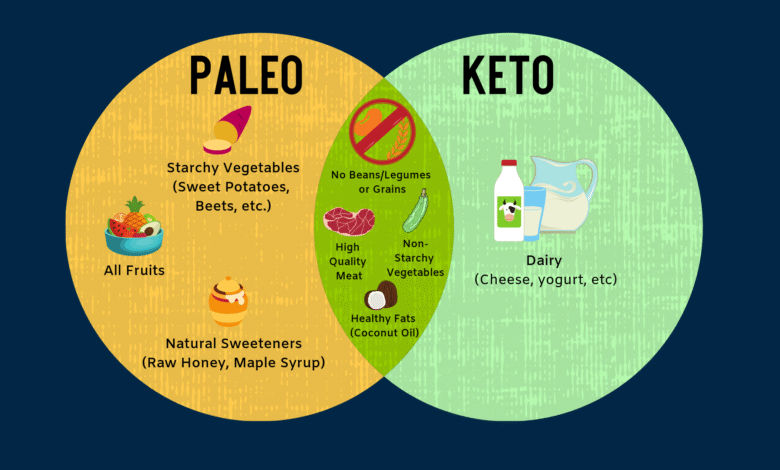Keto vs Paleo for Weight Loss: Proven Diet Comparison for Fat Burning and Healthy Living

Choosing between Keto and Paleo diets for weight loss is one of the most debated questions in nutrition and fitness. Both diets promise fat loss, improved health, and lifestyle changes, but they achieve these results differently. In this 7,000-word deep dive, we’ll explore the science, pros, cons, and real-life results of Keto vs Paleo, so you can decide which diet aligns with your weight loss goals, health needs, and long-term lifestyle.
Understanding the Keto Diet
The Ketogenic Diet (commonly known as Keto) is a low-carb, high-fat diet designed to shift your body into a state of ketosis. When carbs are drastically reduced, the body burns fat for fuel, producing ketones that serve as an alternative energy source. Keto has gained massive popularity in the United States, Africa, and Europe, not just for weight loss but also for managing conditions like type 2 diabetes and epilepsy.
In practical terms, Keto emphasizes butter, oils, fatty fish, meats, eggs, cheese, avocados, nuts, and low-carb vegetables. On the flip side, it eliminates bread, rice, pasta, potatoes, and sugary foods. This makes it strict, but extremely effective in quickly shedding pounds and stabilizing blood sugar.
Keto appeals to many because it gives fast, noticeable results, but sticking with it long-term can be challenging due to food restrictions.
Understanding the Paleo Diet
The Paleo Diet—also called the “caveman diet”—focuses on eating foods that our hunter-gatherer ancestors consumed. The idea is that modern processed foods cause chronic health issues, and going “back to basics” restores health and helps with weight management.
Paleo encourages lean meats, fish, fruits, vegetables, nuts, and seeds while cutting out grains, dairy, legumes, and processed foods. It’s less restrictive than Keto because it allows more natural carbs, such as sweet potatoes and fruit.
While Paleo doesn’t put you into ketosis, it works by naturally reducing calorie intake, inflammation, and processed food consumption, all of which help weight loss.
Keto vs Paleo: The Key Differences
| Aspect | Keto Diet | Paleo Diet |
|---|---|---|
| Carbs | Very low (20–50g per day) | Moderate (from fruits, veggies, sweet potatoes) |
| Fat Intake | Very high (70–80% of daily calories) | Moderate to high (from natural sources) |
| Protein | Moderate | High |
| Weight Loss Speed | Fast (due to ketosis and water loss initially) | Steady and sustainable |
| Flexibility | Restrictive (hard to maintain long-term) | Flexible (more food variety) |
| Focus | Metabolic state (ketosis) | Natural eating (whole foods, no processing) |
Both diets can promote weight loss, but Keto does it by forcing fat-burning through ketosis, while Paleo relies on clean eating and balanced nutrition.
Why People Choose Keto
Keto’s biggest appeal is rapid weight loss. Many people see results within weeks because the body burns stored fat for energy.
Other reasons include:
- Appetite suppression (ketones reduce hunger).
- Improved focus and energy stability.
- Potential benefits for diabetes management.
However, downsides like the “Keto flu,” nutrient deficiencies, and long-term sustainability often turn people away.
Why People Choose Paleo
Paleo attracts people who want a healthier lifestyle rather than a temporary weight loss fix. Since it allows fruits, starchy vegetables, and more natural options, it’s easier to sustain.
Its benefits include:
- Anti-inflammatory effects.
- Better digestion and gut health.
- Sustainable long-term eating habits.
The main challenge? Cutting out grains and dairy can feel restrictive, and Paleo may not deliver the fast fat-burning effect that Keto does.
Keto vs Paleo for Weight Loss: Which is More Effective?
The truth is, both diets work—but in different ways.
- If you want fast fat loss, Keto usually wins because ketosis rapidly burns fat.
- If you want long-term health and lifestyle balance, Paleo is the safer choice.
Your choice depends on whether you value speed or sustainability.
The Science Behind Keto and Weight Loss
Research shows Keto diets can lead to greater short-term weight loss than low-fat diets. By reducing carbs, your body switches to fat as its primary fuel, leading to accelerated fat burning.
But the issue arises in long-term adherence. Many studies show that after one year, Keto and other diets lead to similar results because sustainability matters more than the initial drop.
The Science Behind Paleo and Weight Loss
Paleo doesn’t trigger ketosis but naturally reduces calorie intake by eliminating processed foods. It also lowers blood sugar spikes, cravings, and inflammation—all of which contribute to gradual weight loss.
Studies suggest Paleo improves metabolic markers, cholesterol, and satiety, making it an effective long-term diet, especially for those seeking overall health benefits beyond fat loss.
Potential Risks of Keto
- Nutrient deficiencies (low fiber, vitamins).
- Kidney strain from high protein intake.
- Difficulty sustaining strict food rules.
- Side effects like Keto flu, constipation, and fatigue.
Potential Risks of Paleo
- Restrictive (excludes grains, dairy, legumes).
- Risk of calcium and vitamin D deficiency without dairy.
- Can be expensive due to reliance on organic meats and produce.
Which Diet is Right for You?
Ask yourself:
- Do you want quick weight loss, even if it’s tough to stick with? → Choose Keto.
- Do you prefer a balanced, long-term lifestyle change? → Go with Paleo.
Tips for Success on Keto
- Drink plenty of water.
- Include electrolytes to prevent Keto flu.
- Focus on healthy fats, not just bacon and butter.
- Track carb intake strictly.
Tips for Success on Paleo
- Stock up on fresh fruits and vegetables.
- Use nuts and seeds for snacks.
- Focus on lean proteins.
- Avoid processed “Paleo snacks” that defeat the purpose.
Combining Keto and Paleo (Ketogenic Paleo)
Some people merge the two approaches by eating Paleo-approved whole foods but restricting carbs enough to reach ketosis. This hybrid diet emphasizes nutrient-dense, natural foods while leveraging Keto’s fat-burning advantage.
Long-Term Weight Management
Ultimately, whichever diet you choose, consistency and balance matter more than strict rules. Many people transition to a more flexible diet after hitting their weight loss goals, using elements of both Keto and Paleo to maintain results.
Conclusion
Both Keto and Paleo diets can help with weight loss—but they shine in different ways. Keto is powerful for quick fat burning, while Paleo supports sustainable, whole-food living. The best choice depends on your goals, lifestyle, and health needs.
Read Also How to Prevent Hair Loss During Weight Loss: Proven Tips for Healthy Growth
FAQs
1. Can I lose belly fat faster with Keto or Paleo?
Keto may reduce belly fat faster due to ketosis, but Paleo helps you lose it steadily without extreme restrictions.
2. Is Paleo healthier than Keto long-term?
Yes. Paleo is generally more sustainable because it includes a wider variety of nutrients and avoids extreme carb restriction.
3. Can I exercise while on Keto?
Yes, but performance may dip initially until your body adapts to burning fat for energy.
4. Which diet is cheaper: Keto or Paleo?
Paleo can be less expensive because it doesn’t require specialty foods like MCT oils and Keto supplements.
5. Can I switch between Keto and Paleo?
Yes, some people cycle between the two depending on their goals. Just ensure nutrient balance when transitioning.




One Comment